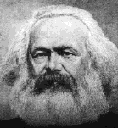![]()
PREFACE


PREFACE
![]()
![]()
The Classical Framework

Karl MarxClassical economic theory is also called labor theory of value because considers labor to be the only essence of economic value. More precisely, Karl Marx, even though many for other reasons don't think of him as a classic economist, considers value as a quantity of labor which crystallizes, or is embodied, into the correspondingly produced commodities.
According to this formulation, if a commodity is produced from the freely available natural resources, its objective value is immediately the quantity of time of labor employed to produce it. If, instead, a commodity is made by using other commodities, or means of production, its value should be calculated as the sum of the quantity of live, or new labor, directly employed to produce it, plus the value transferred by those means of production, which would be, in turn, indirect, or dead labor, that is to say, the quantity of labor previously expended to produce them.
This immediately implies that the time of labor applied in the economic system during the examined period coincides with the value of the net product (mostly composed by consumer goods).The amount of labor embodied in the net product is the whole new labor supplied. It is indeed: (direct and indirect) labor embodied into the product = labor embodied into the means of production + new labor. Moreover: labor embodied into the product = labor embodied into the means of production + labor embodied into the net product. Therefore: new labor = labor embodied into the net product. (Marco Lippi Problemi del socialismo n.21-22 1974 p. 348 Marsilio)
The totality of new labor is equal to the net product of the economic system; or, in other terms, the value of the commodities composing the net product is nothing but the totality of direct labor employed in the system. (G. Somogyi Problemi del socialismo n.1 1976 p. 154 Marsilio)
This relationship between the totality of labor and the value of the net product accords with the concept of economics as the set of relationships aimed toward the satisfaction of needs and the realization of well being (see The Great Mystification). Means of production are not used for the pleasure of using them, but as an intermediate moment in the whole productive process; their use and consumption permits the subsequent availability of consumer goods, the enjoyment of which, during leisure, would be the aim of the entire economic activity, of all the labor.
The value of the net product, then, is also called added value, which coincides with the magnitude of the income. Vianello says:
At the beginning of the year the economic system has a given aggregate of means of production. At the end of the year there is an identical aggregate of means of production plus a new aggregate of commodities, the net product. What happened during the year was the application of labor, which increased the availability of commodities, that is to say, the production of commodities of the net product. The part of the whole production necessary to reintegrate the consumed means of production is not part of the net product, namely, of the income of the economic system, nor can be referred to the currently employed labor. (Ferdinando Vianello Valore, Prezzi e Distribuzione del Reddito Ateneo p. 2)
Supposing that the consumer goods, or the incomes, are distributed in proportion only to the applied quantity of labor, as in the socialistic distribution hypothesis, every worker receives a quantity of commodities which value is identical to the quantity of labor that he spends, and the price of commodities coincides exactly with the quantities of labor objectively embodied in them (as in a system where there are not means of production), and the above framework looks fine.
But in the real capitalistic distribution prices must differ from their objective value in order to ensure the equlibrium of the exchanges, that is, not only a wage proportional to the employed labor, but also a profit proportional to the invested capital, and on the formal level there arises a contradiction known as the problem of transformation from the values to the market prices, which is the incapacity to define the relationships between prices and the given quantities of labor.
Marx correctly, as we'll see, ascribes such a difference to the re-distribution among the capitalists of the whole surplus value, but the problem remains in the fact that the variation of prices is such that even the price of the gross product changes, becoming unpredictably smaller or bigger than the quantity of labor, given in production, by the sum of live labor and labor objectively crystallized into the consumed means of production, which are data, not depending on the possible distribution.
Because of this contradiction, notwithstanding the huge importance of economics for the destiny of our planet, the labor theory of value is considered just as one among the many existing theories; the nature of the economic value remains a mystery and a matter of opinion, and the real, absolute value of the currencies can not be calculated.Whoever wants to know more about the present state of the labor-theory of value can visit:
OPE-L Online (or Outline) Political Economy List
or:
IWGTV International working group on theory of value

The Contradiction of Marx's Framework
Labor, commodity and price are entities inseparably united, yet they remain distinct, so that mathematical operations of sum or subtraction between them are not admissible. Labor indeed does not embodies into the commodities, so that no transfer of dead labor from the consumed means of production to the produced commodities can take place. Among these categories, only the price, which magnitude is eventually determined by distribution - of whatever kind - and not by production, must always be considered as the only actual economic value.
In the uninterrupted chain of transformations, means of production and consumer goods provide different but necessary contributions for the production and reproduction of both of them. Therefore, it is not true that at the "beginning" of the year there are only means of production and at the "end" of the year an identical aggregate of means of production plus the net product. If we consider a period of time of whatever length, we see that initially there are means of production and consumer goods, and at the end there are still means of production and consumer goods, but both are new, others than the consumed ones. If the beliefs of the classical economists were true, therefore, in every period there would constantly be a quantity of labor embodied into the consumed commodities greater than the quantity of labor that has produced them.
The difference between means of production and consumer goods is a distinction of functional, or qualitative, order, which has nothing to do with the nature of economic value, for which commodities are all the objects with a price. Also, even though it is essentially (very) correct to say that labor is not the activity for the direct enjoyment of life, it is possible to feel pleasure when working, and achieve nothing positive or pleasant by using the commodities bought with the income. Satisfaction depends on the actual work, what one buys with the income, and on many other considerations.In reality, the exchange of commodities is nothing but the material aspect of the exchange of labor, and the value indicated by the sum of the price of all the commodities and services (the price of the gross product) sold in any given period of time in an economic system, however they can be distinct, grouped and distributed, is always and only the quantitative representation of all the time of labor which produces them, of the labor of each for the others. This determines the absolute value of the currency used for the exchanges as the command (Smith's concept) upon a precise quantity of social labor, of time of quantified human existence:
Absolute Prices discuss the definition of the economic categories and the relationships between them using Sraffa's formal framework in Production of Commodities by Means of Commodities, leaving aside any consideration of qualitative order about the relationship between economics and well-being.
The price of commodities, no matter how it changes according to distribution, always and immediately expresses a fraction of the whole labor of the economic system, of the human effort employed in the production of commodities.
For this reason money can be used as universal means of exchange, carrying the same meaning and implications for everyone, independently from any particular distinctions between people. Money represents, and its use mechanically and materially, objectively and externally, maintains the social unity of all those who use the same currency in substitution, as shown in The Great Mystification, of the interior awareness of such unity and the knowledge of the nature of economic value itself.

![]()